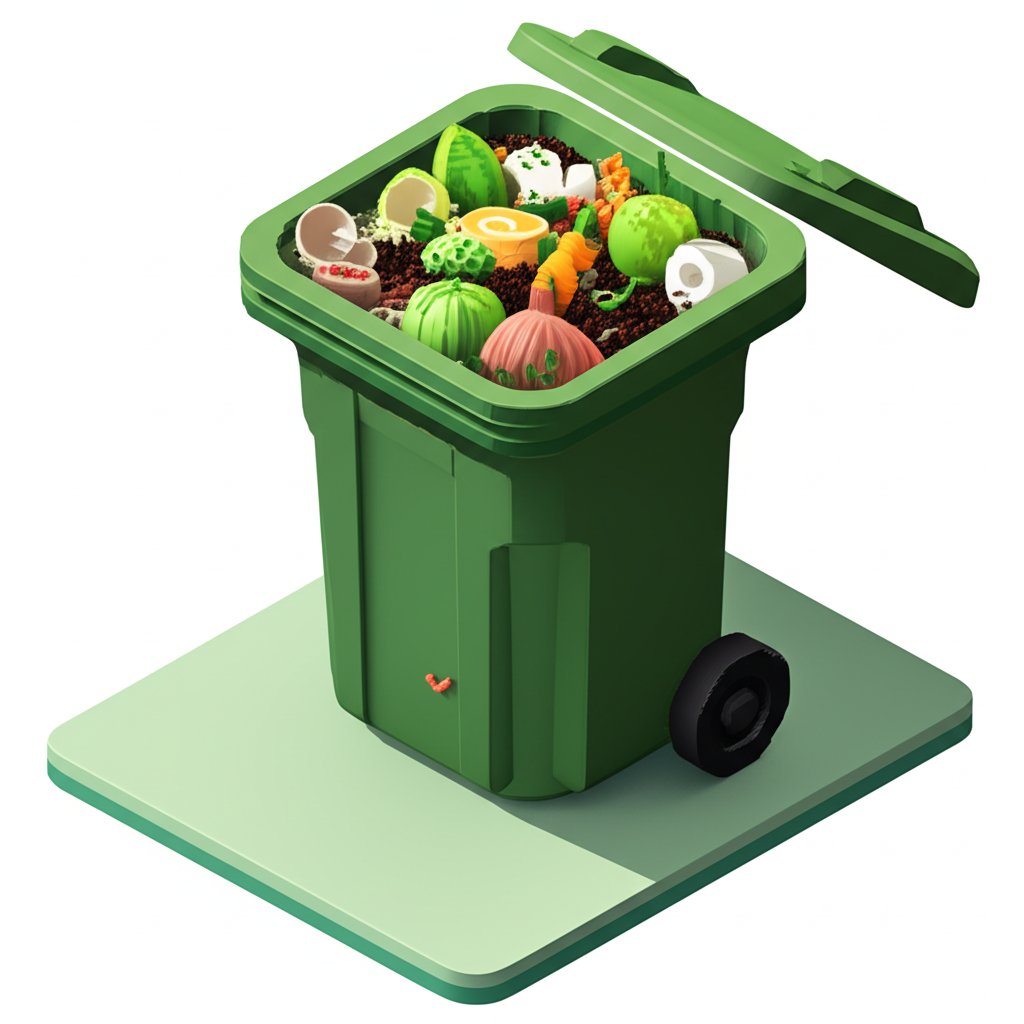Imagine a world where your kitchen scraps and yard trimmings don’t end up in a landfill, but instead transform into a rich, dark, and sweet-smelling soil amendment that breathes life into your garden. This isn’t a fantasy; it’s the profound reality of composting. More than just a gardening technique, composting is a fundamental pillar of sustainable living, a powerful solution for managing organic waste, and a direct path to environmental stewardship.
This article is your definitive guide to unlocking the full potential of composting. We will unravel the intricate science behind the composting process, equip you with invaluable composting tips for every stage, and reveal the far-reaching benefits of composting for your soil, your wallet, and our planet. Whether you’re taking your first steps into sustainable gardening or seeking to refine your methods, prepare to master the art and science of turning your waste into true “garden gold.”
The Science Behind the Magic: Understanding the Composting Process

At its core, composting is a marvel of natural recycling. It’s a controlled biological composting process where a diverse community of microscopic organisms breaks down organic matter, transforming it into a stable, nutrient-rich material called humus. Understanding this intricate dance of decomposition is key to successful composting.
The Microscopic Architects: Bacteria, Fungi, and More
The true heroes orchestrating the composting process are a phenomenal array of microorganisms, working tirelessly to dismantle complex organic structures:
- Bacteria: The primary decomposers, especially in the initial and hottest phases. Thermophilic (heat-loving) bacteria are crucial for active compost piles, driving temperatures up to levels that sterilize the compost, eliminating pathogens and weed seeds.
- Fungi: Essential for breaking down tougher, woody materials like cellulose and lignin. They produce powerful enzymes that can penetrate these resistant compounds, making them accessible to other microbes.
- Actinomycetes: A type of bacteria that gives mature compost its characteristic earthy, “forest floor” smell. They specialize in breaking down more recalcitrant materials that other microbes might struggle with.
- Protozoa: These single-celled organisms feed on bacteria, helping to regulate microbial populations and release nutrients.
- Larger Decomposers (Macroorganisms): While not microscopic, creatures like earthworms, millipedes, and insects contribute significantly by shredding larger pieces of organic waste, aerating the pile, and further digesting materials.
The collective activity of these decomposers generates heat, a tell-tale sign of a healthy, active compost pile. Without these tiny engineers, our planet would literally be buried under its own vegetative matter.
The “Perfect Recipe”: Carbon, Nitrogen, Water, and Air
For these microbial workers to thrive and efficiently convert organic waste into humus, they require a balanced diet and optimal living conditions. The four fundamental ingredients for an effective composting process are:
- Carbon (“Browns”): These are dry, fibrous materials that provide the energy source for microbes. Examples include dried leaves, straw, shredded paper, cardboard, woody chips, and sawdust.
- Nitrogen (“Greens”): These are moist, fresh materials rich in nitrogen, essential for microbial growth and reproduction. Think fruit and vegetable scraps, grass clippings, coffee grounds, and fresh manures.
- Water (Moisture): Critical for microbial activity and the transport of nutrients. The ideal moisture level is akin to a wrung-out sponge – damp to the touch, but not dripping wet. Too dry, and activity slows; too wet, and anaerobic (oxygen-lacking) conditions lead to foul odors.
- Air (Oxygen): Most beneficial composting microbes are aerobic, requiring oxygen to function. Proper aeration, typically achieved through turning, prevents anaerobic conditions, which cause unpleasant smells and significantly slow decomposition.
The golden rule for rapid composting is maintaining an optimal Carbon-to-Nitrogen (C:N) ratio, ideally between 25-30 parts carbon to 1 part nitrogen. While precise measurement isn’t necessary for home composting, aiming for roughly two to three parts “browns” to one part “greens” by volume provides a good balance. This ensures microbes have sufficient fuel (carbon) and building blocks (nitrogen) to efficiently break down organic waste.
Decoding the Stages of Decomposition
The composting process isn’t instantaneous; it progresses through distinct stages, each dominated by different microbial communities:
- Mesophilic Stage (Initial Phase): As you build your pile, moderate-temperature (mesophilic) microbes begin to break down easily digestible compounds. The pile starts to warm up, often reaching temperatures of 68-113°F (20-45°C).
- Thermophilic Stage (Hot Phase): As decomposition intensifies and readily available materials are consumed, temperatures rapidly increase, sometimes soaring to 120-170°F (49-77°C). This high-heat phase is dominated by thermophilic (heat-loving) bacteria, which rapidly break down organic matter and, crucially, destroy most weed seeds and pathogens. This stage is a hallmark of “hot composting” and is vital for producing safe, high-quality compost.
- Cooling & Maturation Stage: After the most easily degradable materials are consumed, the pile gradually cools. Mesophilic bacteria and fungi return, continuing to break down more resistant components. During this period, the compost stabilizes, developing its characteristic dark color, crumbly texture, and earthy aroma. This final, stable product is often referred to as humus or “black gold.”
From Scraps to Soil: A Step-by-Step Guide to the Composting Process
Ready to transform theory into practice? Here’s a comprehensive guide to initiating and maintaining your composting process, brimming with practical composting tips.
Choosing Your Composting Method
The ideal composting method aligns with your available space, time commitment, and the volume of organic waste you generate.
- Backyard Piles & Bins:
- Open Piles: The simplest and most budget-friendly if you have ample space. Materials are simply stacked. Requires regular turning for aeration.
- Compost Bins: Enclosed structures (plastic, wood, wire mesh) that offer better temperature retention, aesthetics, and pest deterrence. Options include:
- Static Bins: Simple containers where material is added and left to decompose. Requires manual turning with a pitchfork or aerator.
- Tumbling Composters: Rotating drums that make turning easy and efficient, often speeding up the process. Great for smaller spaces and frequent turning.
- Multi-chamber Systems: Two or three connected bins allowing for continuous composting, with fresh material added to one chamber while others mature.
- Vermicomposting (Worm Composting): This method uses specialized composting worms (typically Red Wigglers, Eisenia fetida) to break down food scraps in a contained bin. It’s excellent for small spaces, apartments, and produces nutrient-rich vermicompost (worm castings) and “worm tea” (liquid fertilizer). A superb method for handling kitchen
organic wasteefficiently indoors or in shaded outdoor areas. - Bokashi Composting: An anaerobic fermentation process that “pre-composts” food scraps (including meat and dairy) using inoculated bran. The fermented material then needs to be buried or added to a traditional compost pile to fully break down. It’s valuable for those without outdoor space or who wish to process a wider range of food waste before traditional composting.
Selecting the Ideal Location and Essential Tools
The right setup is crucial for a smooth composting process and successful results.
- Location:
- Shade or Partial Shade: Prevents the pile from drying out too quickly, especially in hot climates.
- Well-Drained Area: Avoids waterlogging, which can lead to anaerobic conditions.
- Accessibility: Easy access for adding materials, turning, and harvesting.
- Proximity: A reasonable distance from your home to prevent potential odors (though a well-managed pile rarely smells) and deter pests.
- Equipment:
- Composter: Your chosen bin, pile, or worm bin.
- Pitchfork or Compost Aerator: Indispensable for turning and aerating the pile.
- Watering Can or Hose: For maintaining optimal moisture.
- Shredder (Optional but Recommended): For breaking down larger woody browns, significantly speeding up decomposition.
- Gloves and Shovel: For handling materials and harvesting finished compost.
- Compost Thermometer (Optional): For monitoring internal temperatures, especially for hot composting.
Building Your Compost Pile: Layering for Success
Proper layering is a foundational composting tip for initiating and maintaining efficient decomposition.
- Base Layer: Start with a 4-6 inch layer of coarse “brown” material like twigs, straw, or wood chips at the bottom. This ensures good airflow beneath the pile and prevents it from becoming waterlogged.
- Alternating Layers:
- Add a layer of “browns” (e.g., dried leaves, shredded newspaper, cardboard, small wood chips) – about 6-8 inches thick.
- Follow with a layer of “greens” (e.g., kitchen scraps, grass clippings, coffee grounds) – about 2-4 inches thick.
- Lightly moisten each layer as you add it to achieve that damp sponge consistency.
- Repeat this process, alternating browns and greens, striving for the recommended C:N ratio (roughly 2-3 parts browns to 1 part greens by volume).
- Critical
composting tip: Always bury new kitchenorganic wastedeep within the pile. This helps deter pests and minimizes odors.
- Topping Off: Finish with a layer of “brown” material to act as a cap, conserving moisture and further deterring pests.
Mastering Maintenance: Turning, Watering, and Feeding
Consistent maintenance transforms a simple pile of organic waste into fertile compost.
- Turning (Aeration): This is arguably the most crucial
composting tipfor active piles.- Hot Composting: Turn every 2-4 days, especially when temperatures begin to dip after reaching their peak. This reintroduces oxygen, thoroughly mixes materials, prevents compaction, and helps distribute heat and moistureevenly.
- Cold Composting: Turn every 2-4 weeks, or at least once a month. While slower, this still helps aeration and speeds up breakdown.
- A well-aerated pile guarantees aerobic decomposition, preventing the unpleasant, rotten odors associated with anaerobic conditions.
- Watering (Moisture): Check the moisture level frequently. The pile should always feel like a damp sponge.
- Too Dry: Decomposition slows significantly. Add water with a hose or watering can, turning as you do so to distribute moisture evenly.
- Too Wet: Can lead to anaerobic conditions and foul smells. Add more dry “brown” materials and turn thoroughly to aerate.
- Feeding (Adding Materials): Continuously add new “greens” and “browns” as you generate organic waste. Remember to chop larger items into smaller pieces to accelerate their breakdown.
- Temperature Monitoring (Optional but Recommended for Hot Composing): A compost thermometer allows you to track internal temperatures, ensuring the pile reaches and maintains the thermophilic range (120-170°F) necessary to kill pathogens and weed seeds.
Troubleshooting Common Composting Problems
Even seasoned composters encounter issues. Here’s a quick guide to common problems and composting tips for their resolution:
- Foul Odors (Rotten Egg, Ammonia): The most frequent complaint, usually indicating an imbalance.
- Rotten Egg Smell (Anaerobic): Too much moisture and/or insufficient aeration. Immediately turn the pile, add more dry “brown” materials (shredded paper, dry leaves), and ensure good drainage.
- Ammonia Smell (Too Much Nitrogen): Too many “greens.” Add more “brown” materials and turn the pile well to integrate.
- Pests (Rats, Flies, Raccoons):
- Ensure all food scraps are buried deep within the pile, preferably under 6-8 inches of brown material.
- Avoid adding meat, dairy, oily foods, or pet waste to the pile.
- Consider a pest-proof compost bin.
- Maintain a hot pile, as high temperatures deter most pests.
- Slow Decomposition / Pile Not Heating Up:
- Too dry: Add water, turning as you go.
- Too wet: Add browns, turn frequently.
- Not enough nitrogen: Add more “green” materials like grass clippings or fresh food scraps.
- Not enough oxygen: Turn the pile more frequently.
- Ingredients too large: Chop materials into smaller pieces.
- Pile too small: A minimum volume (ideally 3x3x3 feet or 1 cubic meter) is often needed to generate and retain sufficient heat for hot composting.
Knowing When Your Garden Gold is Ready: Harvesting and Using Compost
The composting process is complete when the material exhibits these characteristics:
- Dark brown or black in color.
- Crumbly, loose texture, resembling rich soil.
- An earthy, pleasant smell (like a forest floor) – not putrid or sour.
- Original ingredients are no longer recognizable.
Depending on your method and maintenance, this transformation can take anywhere from 2 months (for actively managed hot composting) to over a year (for passive cold composting). Once ready, you can manually sift it to remove any larger, undecomposed pieces (which can be added back to a new pile).
Your homemade “black gold” is now ready to enrich your garden beds, potting mixes, top-dress lawns, or even be steeped into a nutrient-rich “compost tea” for liquid plant feeding.
Maximizing Your Impact: What to Compost & What to Avoid
A foundational composting tip for a healthy and efficient composting process is knowing precisely what types of organic waste to add and, critically, what to avoid. A diverse mix is key.
“Green” Materials (Nitrogen-Rich): Fueling the Breakdown
These materials are typically fresh, moist, and high in nitrogen, providing the “fuel” for microbial growth.
- Fruit and vegetable scraps: Peels, cores, wilted produce, rotten fruits/vegetables.
- Coffee grounds and filters: Excellent nitrogen source.
- Tea bags: (Ensure they are paper or plant-based; remove plastic staples).
- Grass clippings: (Use in moderation to prevent matting and anaerobic odors; mix well with browns).
- Plant trimmings, soft green leaves, spent flowers: From your garden.
- Manure: From herbivores like horses, cows, chickens, and rabbits (ensure it’s aged if possible, but fresh is fine for hot piles).
- Food waste from vegetarian meals: Cooked rice, pasta, bread (in moderation and buried deep within the pile).
“Brown” Materials (Carbon-Rich): The Structural Backbone
These materials are typically dry, woody, and high in carbon, providing energy and crucial structure for airflow.
- Dried leaves: Abundant in autumn, excellent carbon source.
- Shredded newspaper and cardboard: Non-glossy, remove any plastic tape or labels.
- Straw and hay: Great for bulk and structure.
- Wood chips and sawdust: (Aged is preferable, use in moderation, especially from hardwoods).
- Pine needles: Can be used, but in moderation, as they decompose slowly.
- Corn stalks: Chopped into smaller pieces.
- Untreated wood ash: From fireplaces (in small quantities, as it can raise pH).
- Cotton rags: Shredded, ensuring they are natural fibers only, free from synthetic blends.
The “No-Go” List: Items to Strictly Avoid
Some organic waste items should be kept out of your home compost pile due to pest attraction, foul odors, or pathogen risks.
- Meat, fish, bones, and poultry: Attract rodents, flies, and other pests; create intense, foul odors; and can harbor harmful pathogens that typical home compost piles may not reach temperatures high enough to kill.
- Dairy products: Attract pests, create strong odors, and decompose slowly.
- Oily foods, grease, and fats: Attract pests, can become rancid, and slow down the decomposition process by forming a barrier around other materials.
- Pet waste (dog, cat, human): Contains harmful pathogens (e.g., E. coli, Salmonella, parasites) that home compost piles cannot reliably destroy. Note: Specialized, high-temperature municipal systems or composting toilets are designed for this, but not general home composting.
- Diseased plants: Can spread pathogens and diseases back into your garden.
- Weeds with seeds: Unless your pile consistently reaches high thermophilic temperatures (above 140°F/60°C for several days), seeds might survive and sprout in your garden.
- Treated wood products: Contain chemicals (preservatives, paints) that are toxic to soil and plants.
- Glossy paper, magazines, colored inks: May contain heavy metals or toxic compounds that should not be introduced into your garden.
- Plastic, glass, metal: Non-organic materials that will not break down in a compost pile.
Pre-Processing Your Waste: Speeding Up Decomposition
A quick composting tip to significantly accelerate the composting process is to prepare your materials before adding them:
- Chop or Shred: Smaller pieces have more surface area for microbes to work on, leading to faster breakdown. Chop kitchen scraps, shred leaves with a mower, and tear cardboard into small pieces.
- Mix: If possible, mix your “greens” and “browns” before adding them to the pile, or ensure they are well-distributed as you layer. This provides better nutrient and moisture distribution for the microbes.
The Unrivaled Benefits of Composting: Why It Matters Most
The benefits of composting are profound and far-reaching, extending beyond just reducing waste to positively impacting our environment, economy, and personal well-being. This is where managing organic waste responsibly truly shines.
Environmental Stewardship: Reducing Landfill Waste & Methane Emissions
- Drastic Reduction in Landfill Volume: Food scraps and yard waste constitute a staggering 20-30% of what global communities send to landfills. Composting these materials directly diverts them, significantly extending landfill lifespans and reducing the need for new sites.
- Mitigation of Methane Emissions: When
organic wastedecomposes in the oxygen-deprived environment of a landfill, it produces methane (CH4). Methane is a potent greenhouse gas, approximately 25 times more effective at trapping heat than carbon dioxide over a 100-year period. Composting, being an aerobiccomposting process, dramatically reduces methane production, making it a powerful tool in combating climate change. - Decreased Chemical Usage: Healthy, compost-enriched soil naturally teems with beneficial microorganisms and nutrients, greatly reducing the need for synthetic chemical fertilizers and pesticides. This prevents harmful chemical runoff into waterways, protecting aquatic ecosystems and biodiversity.
- Conservation of Natural Resources: By recycling valuable nutrients back into the soil, composting lessens our reliance on non-renewable resources used in the manufacturing and transport of synthetic fertilizers.
Garden & Soil Health: Transforming Your Landscape
Compost is rightly revered as “black gold” due to its unparalleled positive impact on soil structure, health, and plant vitality. The benefits of composting for any gardener are immense:
- Nutrient Enrichment & Slow Release:
Compostslowly releases a wide array of essential macro- and micronutrients, providing a steady, balanced food source for plants. Unlike synthetic fertilizers that can leach away, compost holds nutrients in the root zone. - Improved Soil Structure: It enhances soil aggregation, creating a crumbly, porous structure. In heavy clay soils, this improves aeration and drainage, preventing compaction. In sandy soils, it increases the soil’s ability to hold water and nutrients.
- Increased Water Retention: Compost acts like a natural sponge, significantly increasing the soil’s water-holding capacity. This means less frequent watering, a critical
benefit of compostingin drought-prone regions and for water conservation efforts. - Suppression of Plant Diseases & Pests: Biologically active soil, rich with beneficial microorganisms from compost, creates a competitive environment that can suppress pathogenic organisms. Stronger, healthier plants are naturally more resistant to diseases and pests.
- Balances Soil pH: Compost has a moderating effect on soil pH, buffering against extreme acidity or alkalinity over time, making nutrients more available to plants.
Economic & Resource Conservation: Saving Money and Water
The benefits of composting extend to your wallet and resource use:
- Reduced Fertilizer Costs: Producing your own nutrient-rich soil amendment eliminates or drastically reduces the need to purchase commercial fertilizers, topsoil, and mulches.
- Decreased Water Bills: Improved soil water retention directly translates to less frequent irrigation and lower water consumption, a tangible saving for homeowners and municipalities.
- Lower Waste Disposal Fees: In many areas, reducing your household
organic wastecan lead to lower trash collection fees. - Support for Local Food Systems: By making gardening more accessible and productive,
compostingindirectly supports local food production, food security, and fosters community resilience.
Community & Personal Well-being: Fostering Sustainable Habits
Beyond the tangible, composting nurtures a deeper connection to nature:
- Promotes Environmental Stewardship: Engaging in the
composting processinstills a deeper understanding of nature’s cycles and fosters a sense of responsibility towardsorganic wastemanagement. - Educational Opportunity: It’s an excellent, hands-on learning experience for children and adults alike, teaching about decomposition, nutrient cycles, and sustainable living.
- Reduces Carbon Footprint: Actively reducing landfill waste and associated methane emissions directly contributes to global efforts against climate change.
- Creates a Sense of Accomplishment: Witnessing the transformation of “waste” into a valuable resource is incredibly rewarding, empowering individuals to make a positive, measurable difference.
Advanced Composting Techniques & Future Considerations
Beyond the basics, there are nuances and larger-scale approaches to composting that can enhance efficiency, cater to specific needs, or hint at broader applications.
Hot Composting vs. Cold Composting: A Strategic Choice
The composting process can be approached with varying levels of intensity:
- Hot Composting: This method aims for rapid decomposition, often yielding finished compost in a matter of weeks to months. It requires active management of the pile’s C:N ratio, moisture, and frequent aeration (turning) to consistently maintain high temperatures (120-170°F or 49-77°C). The primary
benefits of compostingthis way include significantly faster results and the effective destruction of most weed seeds and pathogens. It’s more labor-intensive but highly rewarding. - Cold Composting (Passive): This is a slower, less labor-intensive approach. You simply pile
organic wasteand let nature take its course with minimal intervention. It can take anywhere from 6 months to over a year to produce finished compost. While easier, it typically does not reach temperatures sufficient to kill all weed seeds or pathogens, and is best for low-risk materials.
Community & Municipal Composting Programs
For urban dwellers, those with limited space, or individuals generating large quantities of organic waste, community or municipal composting programs offer excellent alternatives. These larger-scale composting process programs often involve:
- Drop-off Sites: Designated locations where residents can bring their food scraps and yard waste.
- Curbside Collection: Similar to recycling, specialized bins are provided for
organic wastepick-up from homes. - Community Gardens: Many shared garden spaces include communal compost bins for members.
These larger operations often utilize advanced techniques like aerated static piles or windrow composting, capable of processing massive volumes of organic waste and maintaining consistent high temperatures for thorough pathogen destruction.
Specialized Composting: Bokashi & Vermicomposting Deep Dive
While introduced earlier, these methods offer unique advantages worth exploring further as advanced composting tips:
- Bokashi Composting: This Japanese method isn’t true composting but an anaerobic fermentation. It uses a special bran inoculated with effective microorganisms (EM). Food scraps (including meat, dairy, and cooked foods often avoided in traditional bins) are layered with bokashi bran in an airtight bucket. The fermentation “pickles” the waste, eliminating odors and breaking it down into a pre-composted material that’s then buried in the garden or added to a traditional compost pile for final decomposition. It’s fast, neat, and handles a wider range of food waste.
- Vermicomposting (Worm Composting): Utilizing Red Wiggler worms, this method excels at breaking down kitchen scraps into incredibly rich, nutrient-dense worm castings. It’s odorless, compact, and ideal for indoor use. The worms consume organic waste rapidly, producing “vermicompost” that is teeming with beneficial microbes and plant-available nutrients. It’s a gentle, continuous
composting processthat provides a complete ecosystem in miniature.
The Composting of Human Waste: A Specialized Field
While composting human waste (often referred to as humanure) is technically possible, it is a highly specialized area with significant health and safety considerations. Composting toilets are engineered systems designed to manage human waste through aerobic decomposition, often separating liquids from solids. The resulting compost must reach specific temperatures for extended periods to ensure the complete destruction of harmful pathogens before it can be used. Even then, its application is generally restricted to ornamental gardens or landscaping, not food crops, to prevent potential contamination. This is a complex composting process not suitable for typical backyard piles and demands careful research and strict adherence to local regulations and health guidelines.
Conclusion: Embrace the Power of Composting
You are now equipped with the comprehensive knowledge to master composting – from understanding the intricate science of decomposition and the precise composting process to implementing actionable composting tips and reaping the immense benefits of composting. By consciously transforming your organic waste into nutrient-rich compost, you are doing far more than just creating “black gold” for your garden; you are actively contributing to a healthier planet.
This journey is about reducing landfill waste, mitigating harmful greenhouse gas emissions, conserving precious natural resources, and fostering a vibrant, resilient ecosystem right in your backyard. It’s an empowering, rewarding practice that yields tangible results for your plants and a profound positive impact on our shared environment.
Embrace the power of composting today. Nurture your soil, close the loop on organic waste, and witness the magical transformation of discards into life-giving garden gold.
FAQ: Your Composting Questions Answered

Q1: What size should my compost pile or bin be for efficient composting?
A1: For effective hot composting, where the pile heats up sufficiently to kill pathogens and weed seeds, an ideal size is at least 3 feet x 3 feet x 3 feet (approximately 1 cubic meter). This volume is generally necessary to generate and retain enough heat for rapid decomposition. Smaller bins or piles can still work, but the composting process will be slower, characteristic of cold composting.
Q2: Can I compost all food scraps?
A2: While most plant-based food scraps (fruits, vegetables, coffee grounds, tea bags) are excellent for composting, you should avoid adding meat, fish, bones, dairy products, and oily foods to a typical home compost pile. These items can attract pests (rodents, flies), create foul odors, and may not decompose completely or safely without reaching very high, consistent temperatures that are difficult to maintain in a backyard setup.
Q3: How often should I turn my compost pile?
A3: For active, hot composting, turning the pile every 2-4 days is ideal. This introduces oxygen,










